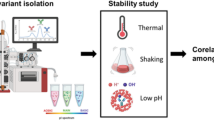Abstract
The effects of salt concentration in mobile phase, elution strategy, and hydrophobicity of stationary phase on lysozyme refolding in hydrophobic interaction chromatography (HIC) were investigated. Butyl Sepharose 4 Fast Flow, the least hydrophobic HIC resin among the tested adsorbent, showed the best refolding yield. The binding efficiency of unfolded lysozyme on the adsorbent was maximized when 1 and 0.4 M of initial and final concentration of ammonium sulfate was used in mobile phase, respectively. The optimum gradient strategy for refolding and elution of lysozyme was determined as linear increase of urea concentration to 4M. The optimized condition suggests the less hydrophobic environment than conventionally used salt solutions and HIC resins. Consequently, total refolding yield was improved 1.6 times comparing with optimized dilution-based batch refolding method.
Similar content being viewed by others
References
To, B. C. S. and A. M. Lenhoff (2007) Hydrophobic interaction chromatography of proteins 1. The effects of protein and adsorbent properties on retention and recovery. J. Chromatogr. A 1141: 191–205.
Goldberg, M. E., R. Rainer, and J. Rainer (1991) A kinetic study of the competition between renaturation and aggregation during refolding of denatured-reduced egg white lysozyme. Biochemistry 30: 2790–2797.
Li, J. -J., Y. Liu, F. Wang, G. Ma, and Z. Su (2004) Hydrophobic interaction chromatography correctly refolding protein assisted by glycerol and urea gradient. J. Chromatogr. A 1061: 193–199.
Cho, E. K. (2007) Enhanced tolerance against freezing stress in Escherichia coli cells expressing an algal cyclophilin gene. Biotechnol. Bioprocess Eng. 12: 502–507.
Kopito, R. R. (2000) Aggresomes, inclusion bodies and protein aggregation. Trends Cell Biol. 10: 524–530.
Jungbauer, A. and W. Kaar (2007) Current status of technical protein refolding, J. Biotechnol. 128: 587–596.
Batas, D. and J. B. Chaudhuri (1996) Protein refolding at high-concentration using size-exclusion chromatography. Biotechnol. Bioeng. 50: 16–23.
Gu, Z., Z. Su, and J. C. Janson (2001) Urea gradient size-exclusion chromatography enhanced the yield of lysozyme refolding. J. Chromatogr. A 918: 311–318.
Creighton, T. E. and D. L. Oxender (1986) UCLA Symposia on Molecular and Cellular Biology. pp. 249–257. A. R. Liss, NY, USA.
Glynou, K., P. C. Ioannou, and T. Christopoulos (2003) one-step purification and refolding of recombinant photoprotein aequorin by immobilized metal-ion affinity chromatography. Protein Expression Purif. 27: 384–390.
Geng, X. and X. Chang (1992) High-performance hydrophobic interaction chromatography as a tool for protein refolding. J. Chromatogr. A 599: 185–194.
Lienqueo, M. E., A. Mahn, J. C. Salgado, and J. A. Asenjo (2007) Current insights on protein behavior in hydrophobic interaction chromatography. J. Chromatogr. B 849: 53–68.
Shugar, D. (1952) The measurement of lysozyme activity and the ultraviolet inactivation of lysozyme. Biochem. Biophys. Acta 8: 302–309.
Hamada, H. and K. Shiraki (2007) L-argininamide improves the refolding more effectively than L-arginine. J. Biotechnol. 130: 153–160.
Lin, F. Y., W. Y. Chen, and M. T. W. Hearn (2001) Microcalorimetric studies on the interaction mechanism between proteins and hydrophobic solid surfaces in hydrophobic interaction chromatography: effects of salts, hydrophobicity of the serbent, and structure of the protein. Anal. Chem. 73: 3875–3883.
Geng, X. D. and X. Q. Chang (1992) High-performance hydrophobic interaction chromatography as a tool for protein refolding. J. Chromatogr. A. 599: 185–194.
Lilli, W., C. Z. Wang, and X. D. Geng (2006) Expression, renaturation, and simultaneous purification of recombinant human stem cell factor in Escherichia coli. Biotechnol. Lett. 28: 993–997.
Dan, W. U., C. Z Wang, and X. D. Geng (2007) Effect of mobile phase on the mass recovery of rhIFN-γ in protein folding liquid chromatography. Chinese J. Chromatogr. 25: 197–202.
Wang, F., Y. Liu, J. Li, G. Ma, and Z. Su (2006) On-column refolding of consensus interferon at high concentration with guanidine-hydrochloride and polyethylene glycol gradients. J. Chromatogr. A 1115: 72–80.
Wang, S. S.-S., Y.-T. Hung, P. Wang, and J. W. Wu (2007) The formation of amyloid fibril-like hen egg-white lysozyme species induced by temperature and urea concentration-dependent denaturation. Kor. J. Chem. Eng. 24: 787–795.
Author information
Authors and Affiliations
Corresponding author
Rights and permissions
About this article
Cite this article
Hwang, SM., Kang, HJ., Bae, SW. et al. Refolding of lysozyme in hydrophobic interaction chromatography: Effects of hydrophobicity of adsorbent and salt concentration in mobile phase. Biotechnol Bioproc E 15, 213–219 (2010). https://doi.org/10.1007/s12257-009-0216-7
Received:
Accepted:
Published:
Issue Date:
DOI: https://doi.org/10.1007/s12257-009-0216-7




